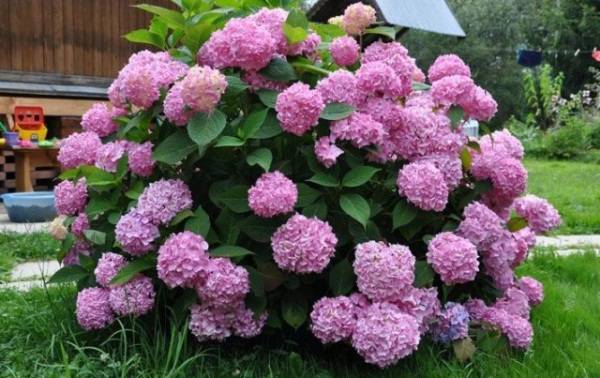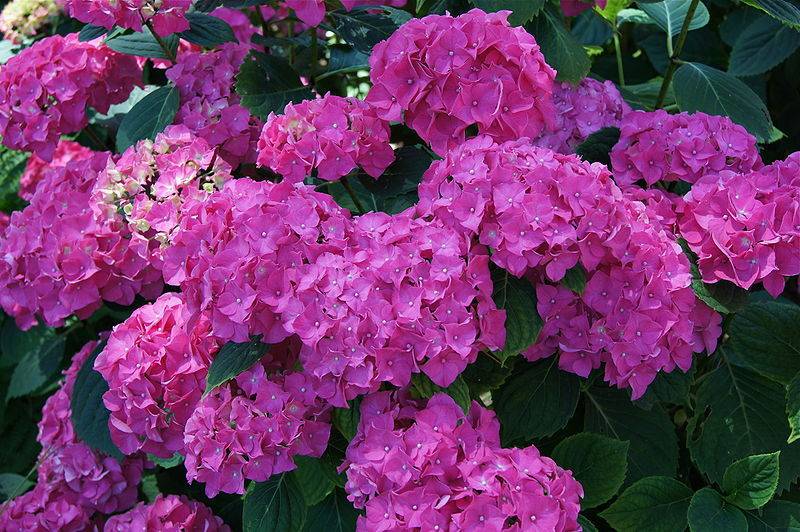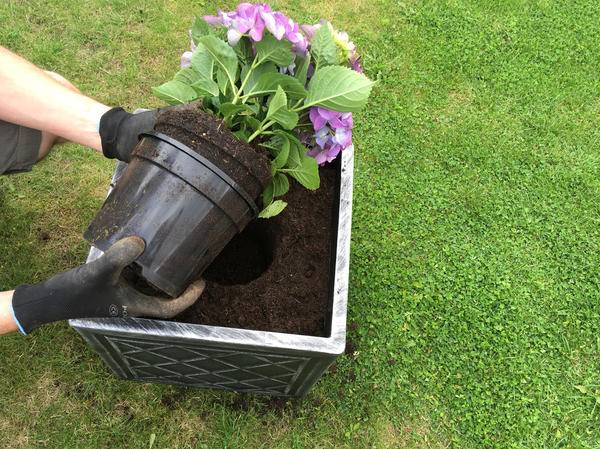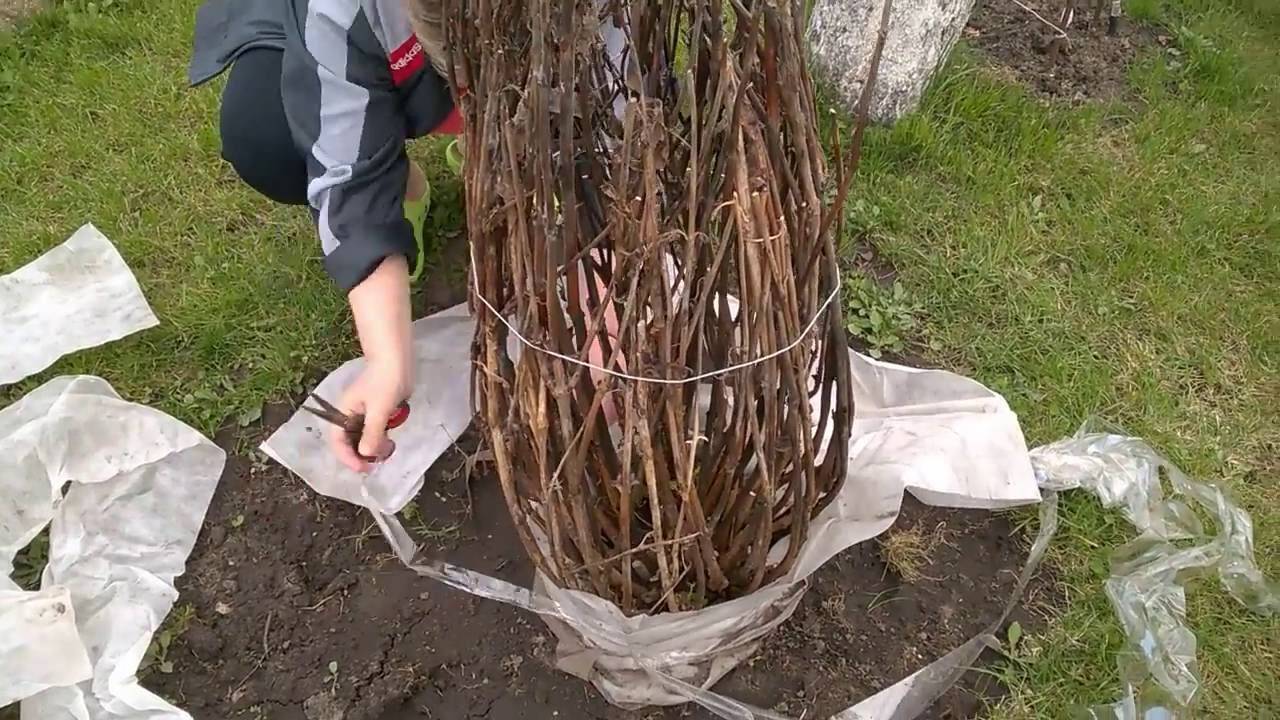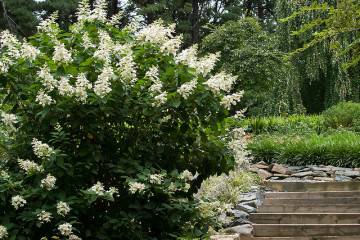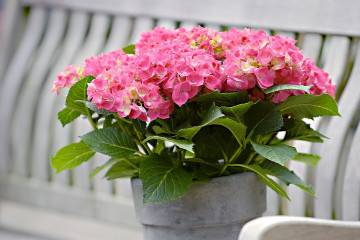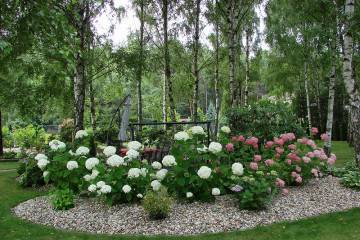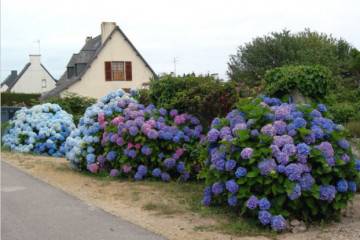Hydrangea pink - how to care for a pink hydrangea in the garden
Content:
Hydrangea pink is a beautiful shrub that is widespread in regions with a temperate climate. Inflorescences, which form bright caps, are considered a characteristic feature of the plant. This decorative culture is a real decoration of the garden. The large-leaved plant is tree-like or paniculate. Each variety has certain characteristics.
The origin and appearance of pink hydrangea
Garden hydrangea pink has a luxurious appearance, but at the same time it is unpretentious in care. The southern and eastern parts of Asia are considered the birthplace of culture. It also grows in the North and South of America. Hydrangeas are especially abundant in Japan and China. The flower can also be seen in Russia. It grows well in the Far East.
Hydrangea flowers resemble balls in appearance. They are large paniculate inflorescences that are found on top of the branches. Most hydrangea varieties have white flowers. However, a large-leaved crop can be decorated with pink, purple and blue buds.
The most beautiful varieties of pink hydrangea
Today, many spectacular varieties of hydrangea are known, each of which has certain characteristics.
Invincible beauty
This large-leaved crop was bred in the United States. The description of the plant says that it is characterized by large bushes with a height of 1.2-1.3 m.In width, it even reaches 1.5 m.
During the flowering period, the bushes are decorated with large inflorescences. Their diameter can be 15-20 cm. The plant has extremely sterile flowers. Their color is different - pink with an ashy shade or deep pink.
Red baron
This perennial crop has four-petalled flowers. They are characterized by a rich crimson color. When the buds open, the core has a greenish color. Then she becomes paler.
The plant has dense stems that are directed vertically. The inflorescences are at the top of the shoot. The shrub is distinguished by active flowering from late July to the second half of September.
To maintain a pure shade, the plant must be planted in neutral soil. For the winter, the trunk circle should be mulched. In summer, it helps to retain moisture, and in the cold season, it protects the roots from freezing.
Matte pink
This variety is characterized by large and decorative inflorescences. They are pink in color with a slight dull lilac tint. The crop can be planted in the sun or in partial shade. It is also placed in places with mixed lighting.
The plant is suitable for single or group plantings. In the second case, it should be planted in combination with other varieties of hydrangeas. Flowers appear on the shoots of the past or current year.
Papillon
This terry culture has flowers that look like roses. At the beginning of flowering, the buds have a rich pink color.During the flowering period, they turn green-red.
The bushes are compact and dense in structure. Hydrangeas in the garden look quite tender and at the same time have bright inflorescences.
Pink Diamond
The culture is a panicle hydrangea. It is characterized by large inflorescences of pink-beige color. The bushes reach 2 m in height. They are characterized by tough and straight shoots, on which small leaves with jagged edges grow.
Hydrangea is considered frost-resistant. It develops well and blooms even in partial shade. Adult bushes do not need to be covered for the winter. At the same time, young plantings should be protected from frost.
If the branches are slightly frozen in winter, they must be removed with the arrival of spring. The culture loves well-moisturized soil. It is especially important to control the amount of watering in hot weather.
Vanilla Fries
This panicle culture is frost-resistant. It stretches several meters in height. The flowers are pyramidal and taper upwards. At first, the culture may bloom white, and then the buds acquire a pale pink color.
Spreading shoots are characteristic of the bushes of this variety. They are distinguished by abundant flowering. However, a large number of buds appear rather late. When grown outdoors, it is better to plant the hydrangea in a well-lit place. Bushes need full watering and moist, fertile soil.
Transplanting pink hydrangeas outdoors after purchase
It is recommended to plant hydrangea in a lighted place. The soil must be sufficiently moist. This is why the culture is planted in low places. At the same time, constant exposure to the sun will lead to a decrease in the size of the flowers.
The flower has a superficial location of the root system. Therefore, neighboring crops must have taproots. Otherwise, rivalry will lead to the death of the flower.
When choosing a soil, it is worth giving preference to a fertile composition. There should be no lime in it. Although the pink hydrangea needs a sufficient amount of moisture, it is necessary to take care of a good drainage layer. Before planting, the soil must be fed. For this, a composition based on peat, humus and sand is used.
It is worth planting a crop in a wide and shallow hole. Hydrangea roots practically do not grow deeper. They grow much stronger in width. This feature should be taken into account when creating a landing recess.
Reproduction of pink hydrangeas
Hydrangea can be propagated by seeds, cuttings, layering. The most difficult method is considered to be seed. It is usually used for breeding purposes. Seeds should be sown for seedlings in March. The flowering of the bushes obtained in this way will begin only after a few years.
When carrying out cuttings, hydrangea begins to bloom the next year. To do this, in the summer, it is worth cutting the shoots from the central part of the bush. They must have 2 pairs of leaves. The length should be up to 17 cm. It is important to choose branches without buds. On them you need to make an oblique cut 1 cm below the kidneys. The resulting fragments should be planted in moist and breathable soil.
Containers with planting material should be placed in partial shade and systematically watered. After 6 weeks, roots are formed on the cuttings. It is forbidden to transplant a young plant immediately. He needs a high-quality wintering. The next year, the culture can be planted on a permanent site.
The most popular option is reproduction by layering. In this case, it is necessary to take a bush shoot and bend it to the ground. Fix the branch with hairpins and sprinkle with soil. Water the plant systematically and top up the soil if necessary.Next spring, the branch can be dug up and planted in a permanent place.
Caring for pink hydrangeas
Planting and caring for pink hydrangea in the open field have certain features that must be taken into account when growing a crop.
First of all, the plant needs to be watered systematically. This shrub is very fond of moisture. Therefore, the correct watering regime should be very abundant. At the same time, it is worth spraying the foliage. Young plants especially need moisture. Before watering, you should dig up the soil near the roots to a depth of 5 cm.
In the first year after planting, hydrangeas do not need feeding. Subsequently, every spring it is worth applying mineral fertilizers. It is especially important to use potassium sulfate in a timely manner.
When buds appear, it is worth feeding the plant again. The last time fertilization is applied in the fall. To increase the strength of the shoots, the bushes can be watered with a weak solution of potassium permanganate.
Features of care during flowering and rest
During the flowering period, the hydrangea needs abundant watering. Also during this period, fertilizers should be used. It is important to remember about a sense of proportion.
During the rest period, the number of waterings is reduced. In autumn, the bushes should be earthed up to 20 cm. After that they should be sprinkled with peat. From above the bushes are covered with a film. You can also use lutrasil. Before using the film, the bushes can be insulated with spruce branches.
Pink hydrangea is a popular garden crop that can decorate any site. To succeed in growing a plant, you need to properly care for it.
